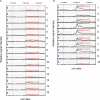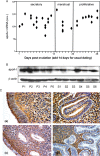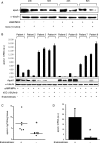Proteomic analysis of endometrium from fertile and infertile patients suggests a role for apolipoprotein A-I in embryo implantation failure and endometriosis
- PMID: 20008415
- PMCID: PMC2834406
- DOI: 10.1093/molehr/gap108
Proteomic analysis of endometrium from fertile and infertile patients suggests a role for apolipoprotein A-I in embryo implantation failure and endometriosis
Abstract
Pregnancy is dependent upon the endometrium acquiring a receptive phenotype that facilitates apposition, adhesion and invasion of a developmentally competent embryo. Surface-enhanced laser desorption/ionization time-of-flight mass spectrometry of mid-secretory endometrial biopsies revealed a 28 kDa protein peak that discriminated highly between samples obtained from women with recurrent implantation failure and fertile controls. Subsequent tandem mass spectroscopy unambiguously identified this peak as apolipoprotein A-I (apoA-I), a potent anti-inflammatory molecule. Total endometrial apoA-I levels were, however, comparable between the study and control group. Moreover, endometrial apoA-I mRNA expression was not cycle-dependent although there was partial loss of apoA-I immunoreactivity in luminal and glandular epithelium in mid-secretory compared with proliferative endometrial samples. Because of its putative anti-implantation properties, we examined whether endometrial apoA-I expression is regulated by embryonic signals. Human chorionic gonadotrophin (hCG) strongly inhibited apoA-I expression in differentiating explant cultures but not when established from eutopic endometrium from patients with endometriosis. Pelvic endometriosis was associated with elevated apoA-I mRNA levels, increased secretion by differentiating eutopic endometrial explant cultures and lack of hCG-dependent down-regulation. To corroborate these observations, we examined endometrial apoA-I expression and its regulation by hCG in a non-human primate model of endometriosis. As in humans, hCG strongly inhibited endometrial apoA-I mRNA expression in disease-free baboons, but this response was entirely lost upon induction of pelvic endometriosis. Together, these observations indicate that perturbations in endometrial apoA-I expression, modification or regulation by paracrine embryonic signals play a major role in implantation failure and infertility.
Figures






Similar articles
-
Is the profile of transcripts altered in the eutopic endometrium of infertile women with endometriosis during the implantation window?Hum Reprod. 2019 Dec 1;34(12):2381-2390. doi: 10.1093/humrep/dez225. Hum Reprod. 2019. PMID: 31796963
-
[Differential expression of microRNA in eutopic endometrium tissue during implantation window for patients with endometriosis related infertility].Zhonghua Fu Chan Ke Za Zhi. 2016 Jun 25;51(6):436-41. doi: 10.3760/cma.j.issn.0529-567X.2016.06.007. Zhonghua Fu Chan Ke Za Zhi. 2016. PMID: 27356479 Chinese.
-
[Study on the relationship between altered expression of annexin A4 and endometrial receptivity during the implantation window in infertile patients with endometriosis].Zhonghua Fu Chan Ke Za Zhi. 2012 May;47(5):324-7. Zhonghua Fu Chan Ke Za Zhi. 2012. PMID: 22883517 Chinese.
-
Epigenetic Factors in Eutopic Endometrium in Women with Endometriosis and Infertility.Int J Mol Sci. 2022 Mar 30;23(7):3804. doi: 10.3390/ijms23073804. Int J Mol Sci. 2022. PMID: 35409163 Free PMC article. Review.
-
Implantation in the baboon: endometrial responses.Semin Reprod Endocrinol. 1999;17(3):257-65. doi: 10.1055/s-2007-1016233. Semin Reprod Endocrinol. 1999. PMID: 10797944 Review.
Cited by
-
Molecular Characterisation of Uterine Endometrial Proteins during Early Stages of Pregnancy in Pigs by MALDI TOF/TOF.Int J Mol Sci. 2021 Jun 23;22(13):6720. doi: 10.3390/ijms22136720. Int J Mol Sci. 2021. PMID: 34201586 Free PMC article.
-
Major protein alterations in spermatozoa from infertile men with unilateral varicocele.Reprod Biol Endocrinol. 2015 Feb 22;13:8. doi: 10.1186/s12958-015-0007-2. Reprod Biol Endocrinol. 2015. PMID: 25890347 Free PMC article.
-
Cervical mucus proteome in endometriosis.Clin Proteomics. 2017 Feb 2;14:7. doi: 10.1186/s12014-017-9142-4. eCollection 2017. Clin Proteomics. 2017. PMID: 28174513 Free PMC article.
-
The endometrial response to chorionic gonadotropin is blunted in a baboon model of endometriosis.Endocrinology. 2010 Oct;151(10):4982-93. doi: 10.1210/en.2010-0275. Epub 2010 Jul 28. Endocrinology. 2010. PMID: 20668030 Free PMC article.
-
Progesterone action in the myometrium and decidua in preterm birth.Facts Views Vis Obgyn. 2012;4(3):33-43. Facts Views Vis Obgyn. 2012. PMID: 24753902 Free PMC article. Review.
References
-
- Ai J, Tan Y, Ying W, Hong Y, Liu S, Wu M, Qian X, Wang H. Proteome analysis of hepatocellular carcinoma by laser capture microdissection. Proteomics. 2006;6:538–546. - PubMed
-
- Akoum A, Lemay A, McColl SR, Paradis I, Maheux R. Increased monocyte chemotactic protein-1 level and activity in the peripheral blood of women with endometriosis. Le Groupe d'Investigation en Gynecologie. Am J Obstet Gynecol. 1996;175:1620–1625. - PubMed
-
- Aoki R, Fukuda MN. Recent molecular approaches to elucidate the mechanism of embryo implantation: trophinin, bystin, and tastin as molecules involved in the initial attachment of blastocysts to the uterus in humans. Semin Reprod Med. 2000;18:265–271. - PubMed
-
- Barnhart K, Dunsmoor-Su R, Coutifaris C. Effect of endometriosis on in vitro fertilization. Fertil Steril. 2002;77:1148–1155. - PubMed
-
- Bedaiwy MA, Falcone T, Sharma RK, Goldberg JM, Attaran M, Nelson DR, Agarwal A. Prediction of endometriosis with serum and peritoneal fluid markers: a prospective controlled trial. Hum Reprod. 2002;17:426–431. - PubMed
Publication types
MeSH terms
Substances
Grants and funding
LinkOut - more resources
Full Text Sources
Medical
Research Materials

